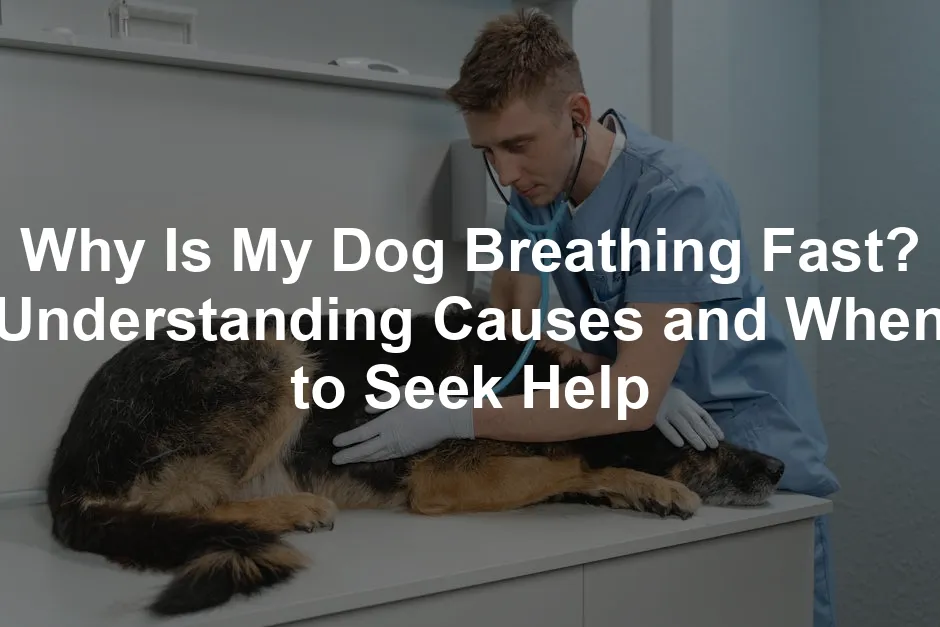
Why Is My Dog Breathing Fast? Understanding Causes and When to Seek Help
Introduction
In the world of dog parenting, few things can send you into a panic like observing your furry friend panting or breathing rapidly for no apparent reason. Is it just a case of excitement, or should we be reaching for the phone to call the vet? Fast breathing, or tachypnea, can be a sign of something serious or simply a normal reaction to heat or exercise. Understanding the nuances of your dog’s breathing can make all the difference.
Dogs typically breathe at a rate of 15 to 35 breaths per minute when at rest. If your pup’s breathing exceeds 40 breaths per minute, that’s when the alarm bells should ring. Various factors can cause rapid breathing, from benign to critical health issues. This guide will help you navigate this concerning symptom. So, grab a treat for your pup, settle in, and let’s unravel the mystery of fast doggie breathing!

Summary
Understanding why your dog is breathing fast can be a daunting task, especially for first-time pet owners. This article will clarify the normal breathing rates for dogs, potential causes of rapid breathing, and crucial signs that indicate when veterinary assistance is necessary.
Common causes of fast breathing include heat, anxiety, and exercise, which are usually benign. However, underlying medical conditions like asthma, pneumonia, or heart disease can also manifest as rapid breathing. Additionally, certain breeds, particularly brachycephalic dogs like Pugs and Boston Terriers, are more predisposed to respiratory issues.
Recognizing the signs of distress is vital; pale gums, open-mouthed breathing at rest, or labored breaths warrant immediate veterinary attention. We will discuss how to monitor your dog’s breathing, what a normal respiratory rate looks like, and when to seek help.
By the end of this article, you will have a clearer understanding of your dog’s respiratory health and the steps to take if you notice anything concerning. Armed with knowledge, you can ensure your furry friend remains happy and healthy!
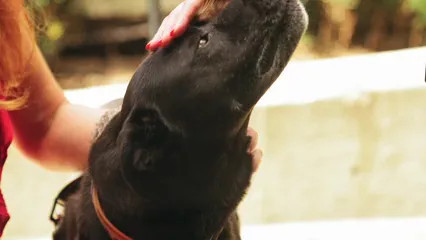
To ensure your dog is always prepared for any situation, consider getting a Dog First Aid Kit. It’s better to be safe than sorry when it comes to your beloved pup!
Potential Causes of Rapid Breathing
Understanding why your dog is breathing fast can alleviate some fears. Rapid breathing can be a normal response to various benign conditions. Heat, excitement, and exercise often lead to increased breathing rates. Dogs don’t sweat like us, so panting helps them cool down efficiently.
However, other factors can indicate serious issues. Conditions like asthma, pneumonia, and heart disease are among the culprits. These medical problems can cause rapid breathing as the body struggles to take in enough oxygen.
Brachycephalic breeds, like Pugs and Boston Terriers, are especially prone to breathing challenges. Their unique anatomy makes it harder for them to breathe. Their short snouts can lead to airway obstructions, especially during stress or heat.
Recognizing the signs of distress is crucial. If your dog shows pale gums, open-mouthed breathing at rest, or labored breaths, it’s time to call the vet. These symptoms indicate they may be struggling to breathe adequately.
Monitoring your dog’s breathing patterns is essential. A normal resting respiratory rate for dogs is 15 to 35 breaths per minute. If you notice anything above 40 breaths per minute, that’s a red flag.
Being proactive about your dog’s respiratory health can make all the difference. If you ever feel uncertain, don’t hesitate to reach out to your veterinarian. Keeping your furry friend healthy and happy is the ultimate goal!

And speaking of health, have you considered getting a Pet Thermometer? Keeping track of your dog’s temperature can help you identify potential health issues early!
What is a Normal Breathing Rate for Dogs?
When it comes to our furry friends, knowing what’s normal is key! For dogs, a typical resting breathing rate ranges from 15 to 35 breaths per minute. This means your pooch is taking in air comfortably without any fuss. But if you start counting and hit over 40 breaths per minute while your dog is resting, it might be time to raise the alarm.
So, how do you measure this? It’s easier than trying to convince your pup to take a bath! Simply watch them when they are calm—preferably when they’re dozing off in their favorite sunbeam. Count their breaths for a full minute. One full breath is counted when your dog inhales and exhales. Keep in mind, the best time to do this is when they’re relaxed, not after a romp in the park!
Several factors can influence your dog’s breathing rate. For instance, temperature plays a significant role. On a hot summer day, you might notice your dog panting like a marathon runner. Exercise is another culprit. After a spirited game of fetch, your dog’s breathing will naturally quicken. And let’s not forget about stress or excitement! A doorbell ring or a surprise visitor can send your dog’s heart racing, leading to faster breaths.
Understanding these normal rates is crucial for monitoring your pup’s health. If you notice any significant deviations, don’t hesitate to consult your veterinarian. After all, keeping an eye on your dog’s breathing is just one way to ensure they’re always feeling their best!

If your dog enjoys their meals, consider investing in some high-quality Dog Bowls. A good bowl can make mealtime more enjoyable and help prevent spills!
Why Is My Dog Breathing Fast?
If your dog is breathing fast, it can be puzzling. Why is this happening? Let’s break it down! Rapid breathing, or tachypnea, can stem from various physiological responses.
One common cause is exercise. After a vigorous game of fetch, your dog’s breathing will spike. They need more oxygen to keep those tails wagging and energy levels high. Once the fun wraps up, their breathing should return to normal in a few minutes—like a mini cooldown!
Heat is another factor. Dogs don’t sweat like we do, so they rely on panting to cool down. You’ll often see them with their tongues hanging out, working hard to regulate body temperature. This natural mechanism helps them stay cool. If it’s a hot day or your dog has been running around, fast breathing is typically nothing to worry about.
Excitement or stress can also lead to rapid breathing. Picture this: your dog hears the doorbell and gets a burst of adrenaline. They might start breathing faster as they anticipate a fun visitor or a walk. It’s a normal reaction to emotional states.
However, if your dog’s rapid breathing seems excessive or is accompanied by other concerning symptoms, it’s time to take action. Your pup may be experiencing underlying medical issues. Conditions like asthma, pneumonia, or heart disease can manifest as rapid breathing. Additionally, brachycephalic breeds, such as Pugs and Bulldogs, are particularly susceptible to breathing challenges due to their unique anatomy.
Watch out for these signs: if your dog is using their stomach muscles to breathe, has pale gums, or is reluctant to eat or drink, it’s time to call the vet. Fast breathing can sometimes indicate serious health concerns. Remember, being proactive about your dog’s health is the best way to ensure a long, happy life together!
Medical Conditions
Respiratory Issues
Fast breathing can be a red flag. Dogs may suffer from asthma, pneumonia, or bronchitis. Asthma can cause wheezing and difficulty breathing. Pneumonia is an infection that fills the lungs with fluid, making it hard for your dog to breathe. Meanwhile, bronchitis leads to inflammation of the airways. If your dog seems to struggle with normal breaths, consider these conditions.
To keep their breathing in check, a Dog Cooling Mat can be a lifesaver during hot weather!

Heart Problems
Heart disease and congestive heart failure are serious culprits behind rapid breathing. When the heart can’t pump effectively, fluid builds up in the lungs, causing distress. A dog with heart issues may show signs like coughing or lethargy alongside fast breaths. If you see these symptoms, do not wait to seek help.
Infections
Infections like pneumonia or kennel cough can also lead to rapid breathing. Kennel cough is highly contagious and can cause a dry cough, which may be accompanied by fast breathing. Always keep an eye on your pup’s behavior after exposure to other dogs. If they start breathing fast, it’s time to visit the vet.
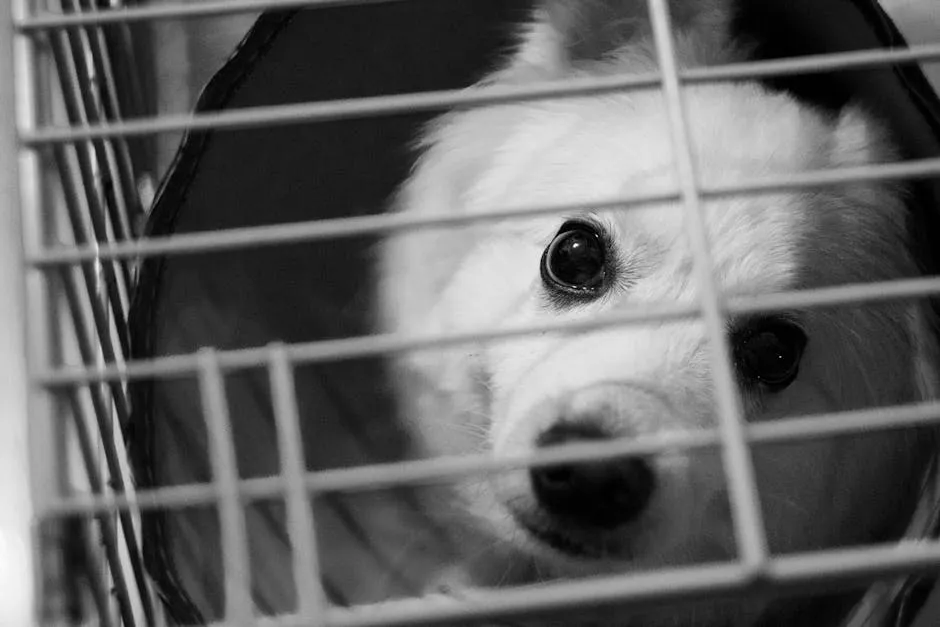
Anemia
Anemia, characterized by a low red blood cell count, can make your dog breathe rapidly. With fewer red blood cells to carry oxygen, their body compensates by increasing breathing efforts. Look for signs of weakness or pale gums—these can indicate anemia. A trip to the vet is essential if you suspect this condition.
Pain
Don’t underestimate the impact of pain on your dog’s breathing. Injuries or illnesses can lead to increased respiratory effort. If your dog is injured or has a medical condition, they may breathe faster as a response to discomfort. Watch for other signs, like whining or reluctance to move, and consult your vet right away.
Pain can significantly affect your dog’s breathing patterns. If you’re curious about the effects of pain on breathing, check out this article on Why do we experience phantom limb pain after amputation.

Breed-Related Factors
Brachycephalic Breeds
Brachycephalic breeds, like Pugs and Bulldogs, are more prone to respiratory distress. Their short noses can lead to airway obstructions. When these dogs get excited or overheated, their breathing difficulties can worsen. Always monitor these breeds closely for signs of trouble, especially in warm weather or during vigorous activities. If you notice fast breathing, take action quickly!

Symptoms to Monitor
Signs of Distress
Monitoring your dog’s breathing is crucial. Labored breathing often involves using their stomach muscles. If you notice this, it’s a sign they’re struggling. Also, check their gum color. Pale or blue-tinged gums can indicate a lack of oxygen. If your pup seems reluctant to eat or drink, that’s another warning sign.
Further, heavy drooling or open-mouthed breathing while at rest are concerning symptoms. These can indicate that your dog is in distress. If you see any of these signs alongside rapid breathing, it’s time to call your veterinarian. Early action can make all the difference in ensuring your furry friend stays healthy and happy.
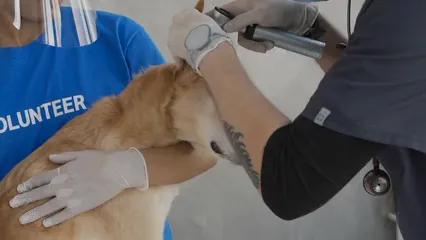
When to Contact Your Vet
If your dog is breathing fast, you might feel a wave of panic wash over you. While some rapid breathing can be harmless, certain signs indicate it’s time to phone a vet. Here are some emergency signs to look out for:
- Labored Breathing: If your dog is using their stomach muscles to help them breathe, it’s a red flag. This means they might be struggling to get enough air.
- Abnormal Gum Color: Check your dog’s gums. If they appear pale, bluish, or brick-red, this can signal oxygen deprivation.
- Reluctance to Eat or Drink: If your pup refuses food or water, it may indicate distress.
- Open-Mouthed Breathing at Rest: Dogs usually breathe through their noses when relaxed. If they’re panting with their mouths open while resting, that’s concerning.
- Excessive Drooling: If your dog is drooling more than usual, it could indicate they’re in trouble.
- Heavy or Loud Breathing: If their breathing sounds different from normal panting, it’s time to act.
Monitoring your dog’s symptoms can help you provide vital information to your vet. Keeping a record of changes in breathing patterns and any accompanying symptoms is essential. Here are some effective monitoring techniques:
- Count Breaths: While your dog is resting, count their breaths for a minute. This can help establish their normal breathing rate.
- Document Changes: Note any unusual behaviors, such as lethargy, coughing, or restlessness. A journal can be a great way to track these changes over time.
- Monitor Environmental Factors: Take note of temperature and stress levels. Did they just have a stressful encounter? Are they in the heat? These factors can contribute to rapid breathing.
Always trust your instincts. If your dog’s behavior seems off, don’t hesitate to reach out to your veterinarian. Quick action can save your furry friend’s life. Remember, better safe than sorry!
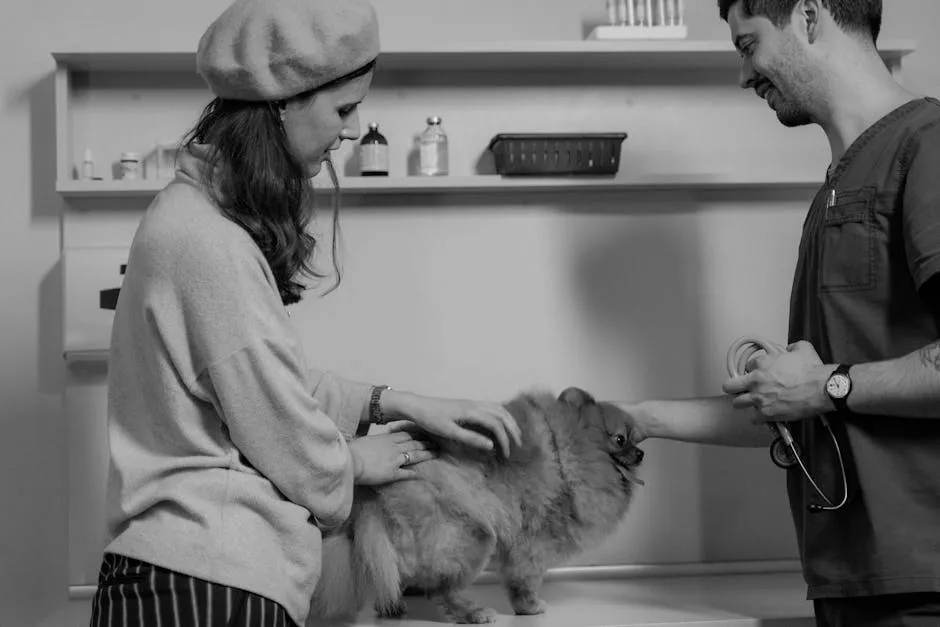
How Will the Vet Diagnose the Cause of My Dog’s Fast Breathing?
When you take your dog to the vet for fast breathing, expect a thorough examination. Your vet will start by taking a detailed history of your dog’s health and any observed symptoms. Here’s what typically happens:
Initial Veterinary Examination
The vet will check your dog’s heart and lungs. They’ll listen for abnormal sounds and assess the overall health condition. They may also evaluate your dog’s behavior and response to stimuli. This initial assessment is crucial in determining the next steps.
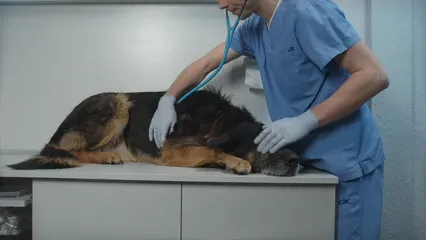
Diagnostic Tests
If the vet suspects an underlying issue, they may recommend diagnostic tests. Common tests include:
- X-Rays: These help visualize your dog’s lungs and heart. They can reveal issues like pneumonia, tumors, or fluid in the lungs.
- Blood Tests: These tests check for infections, anemia, and other health problems. They can provide insight into how well your dog’s organs are functioning.
- Ultrasound: This imaging test allows the vet to examine your dog’s heart and other internal organs more closely.
- Pulse Oximetry: This non-invasive test measures blood oxygen levels, indicating how well your dog is breathing.
The results from these tests help your veterinarian pinpoint the cause of your dog’s fast breathing. Based on the findings, they’ll devise a tailored treatment plan to address the root of the problem. Remember, your proactive approach in seeking help can lead to a better outcome for your beloved pet.
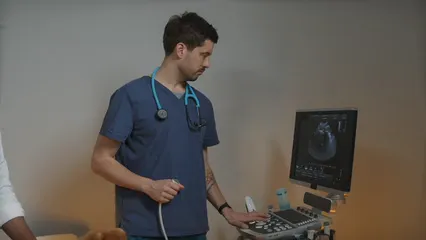
Treatment Options
When it comes to treating your dog’s fast breathing, the key is to address the underlying cause. Treatment options will vary based on what’s going on with your furry friend. Here’s a general overview of what to expect:
General Treatment Approaches
1. Medication: Your vet may prescribe medications to manage symptoms. This could include:
- Pain Relief: If your dog is in pain, medication can help ease their discomfort.
- Antibiotics: If an infection is present, antibiotics will be necessary to tackle it.
- Anti-inflammatories: These can reduce swelling in the airways.
2. Oxygen Therapy: In severe cases, your dog may need supplemental oxygen. This helps them breathe easier and ensures their body gets enough oxygen.
3. Behavioral Training: If anxiety is causing rapid breathing, specialized training may be beneficial. A certified dog behaviorist can work with you and your pup to manage stress.
4. Rest and Hydration: Ensuring your dog gets plenty of rest and stays hydrated is essential. This allows their body to recover more effectively.
5. Monitoring and Follow-Up: Your vet may schedule follow-up appointments to monitor your dog’s progress. This ensures that the treatment is effective and allows for adjustments if necessary.
Understanding the treatment options available is crucial for your dog’s recovery. Work closely with your veterinarian to find the best course of action. Your furry friend’s health and happiness depend on it!
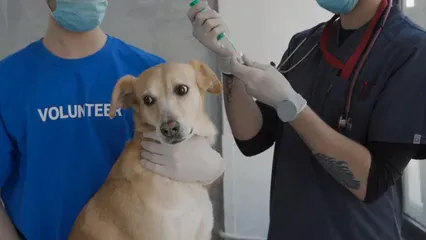
If your dog gets anxious during thunderstorms or fireworks, consider a Dog Anxiety Vest. It can provide comfort and reduce their stress levels!
Please let us know what you think about our content by leaving a comment down below!
Thank you for reading till here 🙂
All images from Pexels




